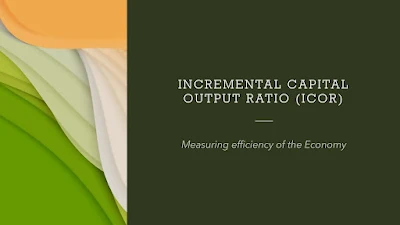Incremental Capital Output Ratio (ICOR):
- Efficiency of an economy is about productivity which refers to how much output can be produced with a given set of inputs.
- Productivity is referred to as =output /input,
If input in a factory is 20 Rs and output is Rs 40 ,then Productivity : 40/20=2.
Now for understanding:
- Reverse the formula of productivity ie 1/productivity = Input/Output;
- Output in an economy is nothing but GDP and input is investment.
- So inverse of productivity at macro level will be :
Input/output ie Investment /GDP;
This ratio of Investment /GDP is referred to as Incremental capital output Ratio ie ICOR.
SIGNIFICANCE OF ICOR:
- ICOR represent the efficiency of economy, how additional capital ie change in investment is being used in a country to produce the output ie change in the GDP.
- ICOR explains the relationship between the increase in investment made in the economy and the consequent increase in Gross Domestic Product (GDP).
- ICOR is inversely proportional to productivity. Higher the ICOR, the lower the productivity of capital or the marginal efficiency of capital.
- The ICOR can be thought of as a measure of the efficiency / inefficiency with which capital is used.
DECIPHERING ICOR IN THE RECENT YEARS :
- From 2016 - 2019, ICOR increased due to demonetization (Nov 16) and GST (Jul 17) which resulted in disruption in economic output.
- So during that time, even though our investment was around 28%, our growth dipped to around 6% resulting in higher ICOR (4.65).
- But since 2022-23, investment was 29.2% and GDP growth was 7.2%, which results in an ICOR of around 4.
So, if India wants to be a developed nation then it needs to grow at 7% for the next 25 years (till 2047) and that will require an investment of 28% with ICOR being 4.





No comments:
Post a Comment